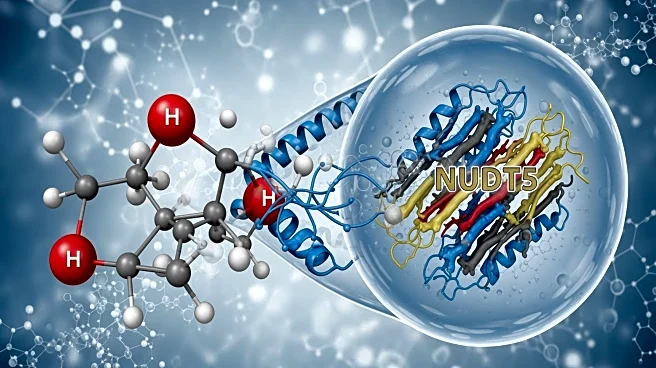What's Happening?
A research team led by Stefan Kubicek, PhD, at the Research Center for Molecular Medicine of the Austrian Academy of Sciences, CeMM, has discovered a novel function of the enzyme NUDT5 in purine synthesis
regulation. Traditionally known for its role in hydrolyzing metabolites, NUDT5 has been found to act as a structural regulator, influencing whether cells continue to produce purines. This discovery was made while exploring the role of MTHFD1 in folate metabolism. The team employed various methods, including genetic engineering and isotope tracing metabolomics, to analyze NUDT5's interaction with other proteins in the folate pathway. Their findings suggest that enzymes can impact cellular functions not only through chemical reactions but also through their physical presence, which can have significant implications for therapeutic approaches.
Why It's Important?
The discovery of NUDT5's structural role in purine synthesis has potential implications for therapeutic strategies, particularly in diseases related to folate metabolism and purine synthesis. Understanding this regulatory network could lead to new treatments for conditions like MTHFD1 deficiency and cancer, where purine synthesis plays a critical role. The research highlights the importance of structural roles in enzymatic functions, which could pave the way for novel drug targets and diagnostic tools. The team's findings also suggest that manipulating NUDT5 could modulate responses to cancer therapeutics, offering potential benefits in reducing toxicity and improving treatment efficacy.
What's Next?
The research team plans to explore chemical tools to modulate the interaction between NUDT5 and PPAT, aiming to control the balance between nucleotide salvage and de novo synthesis. They are also investigating other modulators of nucleotide synthesis pathways and linking their findings to epigenetic control and chromatin structure. Additionally, the development of dNUDT5, a chemical degrader of NUDT5, offers translational possibilities for protecting normal tissues from the toxic effects of antimetabolite therapy. These efforts could lead to significant advancements in personalized medicine and cancer treatment.
Beyond the Headlines
The study opens up new avenues for understanding the 'moonlighting' functions of metabolic enzymes, where they exert roles beyond their traditional metabolic activities. This could lead to a broader recognition of structural roles in cellular processes, influencing future research in molecular biology and biochemistry. The findings also underscore the potential of computational methods in predicting enzyme interactions, which could revolutionize drug discovery and development.











